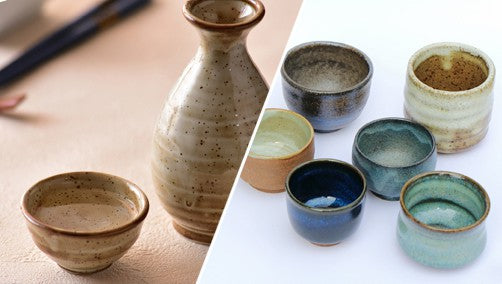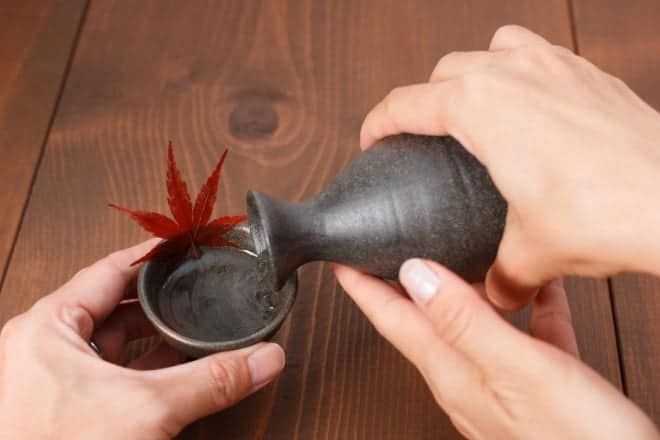Nowadays, the whole world raves about Japanese sake! But not everyone knows the ins and outs of sake cups like “ochoko” and “guinomi.” This can be troublesome for people buying drinking sets online. How do the two kinds of sake cups differ and which one should you go with? Also, is it true that sake tastes differently depending on the cup you drink it from? In this article, we’ll answer these questions and more while introducing our recommended sake drinking sets, so make sure to read to the end!
What’s the Difference Between Ochoko and Guinomi Drinking Cups?

It’s easy to confuse ochoko and guinomi at first glance, especially if you’re shopping online where many cups almost look identical. The main difference between the two is their size and therefore volume. However, there is no law or official definition that restricts each type to however many centimeters. When distinguishing the two cups, we mainly look at whether their contents can be drunk in one gulp.
Ochoko (can be emptied in one gulp): 20 – 50 mL
Guinomi (can’t be emptied in one gulp): 40 – 200 mL
It’s often said that the easiest amount for an adult man to drink in one gulp is about 20 mL, so cups that can hold 20-30 mL of sake are classified as "ochoko." Cups with a volume of 40 mL or more can be called both "ochoko" and "guinomi" depending on the maker. There is no well-defined difference between the two.
What Is an Ochoko Cup?

The “o” in “ochoko” (お猪口) is a Japanese honorific prefix while “choko” means “a little bit.” The word is meant to describe a small cup that you can empty in one gulp.

If you enjoy a little sake at dinner, there is nothing better than a pitcher of sake with an ochoko cup!
What Is a Guinomi Cup?

A "guinomi" is a sake cup larger than an ochoko but smaller than a regular cup. Some say that the name comes from “guitto tsukande nomu” (“to grab firmly and drink down”) or “guigui nomu” (“to drink fast”), but these are just theories and the real etymology of “guinomi” is unknown. In any case, a guinomi cup must be bigger than an ochoko and take about two gulps to empty.
How Do Cups Affect the Taste of Sake?

How Does an Ochoko Cup Affect the Taste of Sake?
Ochoko cups need to be small enough to empty in one gulp, and because they hold such a small amount, they guarantee that your drink won’t become warm when serving cold sake.
How Does a Guinomi Cup Affect the Taste of Sake?
If you serve cold sake in a guinomi cup to someone who’s a slow drinker, their drink might become warm.
What Else Can Affect the Taste of Sake?
Another thing that can affect the taste of sake is the material that the cups are made from. For example, if you’re serving ginjo*, daiginjo*, or some other sake with a fruity aroma and delicate flavor, glass cups are preferred. However, with full-bodied, strong-flavored sake like junmaishu* or yamahai jikomi*, you should go with porcelain.
You can have fun experimenting with different combinations of cups to match people’s preferences, drinking speeds, and the temperature of sake. Though ochoko cups, which are available in many different varieties, tend to only be made for sake due to their small size, the larger guinomi are sometimes also used to serve shochu or even whiskey.
*Trivia: What Is Ginjo, Daiginjo, Junmaishu, and Yamahai Jikomi?
●Ginjo and Daiginjo
Sake is made entirely from polished rice grown especially for sake production. If 60% or less of the rice grain remains after polishing (milling), then the resulting drink will be defined as "ginjo." If this number is 50% or less, then it’ll become "daiginjo." That’s why daiginjo is generally more expensive than other varieties, and because it’s made from well-polished rice, it has a smoother and clearer taste.
●Junmaishu
This type of sake is made from rice, koji (malted rice), and water, with no added brewing alcohol, resulting in a rich, well-rounded, and often full-bodied flavor.
●Yamahai Jikomi
In sake production, there are two main types of “shubo” (yeast mash cultivated from steamed rice, koji malt, and water): the fast-brewing kind and the traditional “kimoto” kind. Yamahai Jikomi is made from the latter, but forgoes the process of “yamaoroshi,” which sees steamed rice placed in a large barrel or tank and mashed with a paddle. Because this process was so labor-intensive and thanks to studies proving no difference in taste between mashed and un-mashed rice, a lot of brewers switched to un-mashed Yamahai Jikomi production.
Recommended Ochoko Sake Sets
As ochoko cups are small and allow sake to be drunk in one gulp, we recommend buying them in sake sets with “tokkuri” pitchers or “katakuchi” servers. Katakuchi are different from tokkuri, as they are flat and have spouts on one side that make it easier to pour alcohol.
Kyo-Kiyomizu Ware: Touan Hanakessho (Ginfuji) Katakuchi Three-Piece Drink Set

This is a Kiyomizu (ceramic style originating in Kyoto) drink set featuring “hanakessho,” silver flower patterns with a blueish touch. The hanakessho design is achieved by coating the piece with a special glaze that melts when fired and crystallizes into flower-shaped patterns once cooled. No two hanakessho pieces are ever the same, so this is the perfect purchase for something truly one-of-a-kind.
Related article: ▶ Kyo Ware/Kiyomizu Ware Guide: Japanese Ceramics (Pottery / Porcelain)
Tsugaru Vidro: Hokuyo Glass (Aderia) Hydrangea Drink Set

This Tsugaru Vidro (traditional Aomori craft) drink set invokes images of raindrops on hydrangeas after a rainstorm. The vivid colors of the flower patterns work perfectly with the smooth shape while the sparkling glass creates an otherworldly effect.
Shun Japan Chirping Bird Ochoko Sake Set

This ochoko sake set not only looks great, but can do a very unique trick. When the bottle is tipped over to pour a drink, the ceramic bird affixed to the top makes a chirping sound! The ochoko themselves, too, have whistle-like tubes on the side that likewise chirp as you take a drink. It seems like a new-fangled idea, but this is actually an old technique that has been pleasing sake drinkers since the Edo period.
Satsuma Kiriko Lapis Lazuli Crystal Ochoko Sake Set

This dazzling crystal sake set is made in Kagoshima, on Kyushu. There, a forgotten style of "kiriko" glass cutting was revived several years ago that features gorgeous multi-colored designs. This set is expensive, but would make an incredible gift for a sake lover.
Recommended Guinomi Cups
Guinomi cups are perfect for those who pour sake with a heavy hand! In this section, we'll introduce two kinds of tokkuri pitcher sets: a delicate glass one and a rustic porcelain one.
Tin and Gold Leaf Guinomi Sake Set

Tin has a variety of chemical properties that make it a great choice for sake cups. For one, it is said to make particularly pungent sake taste milder, which can be very helpful especially for those new to sake drinking. Beyond that, though, this tin set is a beautiful thing to behold, and the cups feel heavy and solid in your hands. No doubt this set can be used for many years without worry of ever breaking it.
Kanazawa Gold Leaf: Hakuichi Drink Set, Champagne Gold

This unique drink set consists of clear glass cups adorned with gold leaf featuring a pattern of mesmerizing irregular cracks. The elegant, soft glint of the champagne-gold Kanazawa gold leaf is the perfect addition to your table, whether you’re entertaining guests or enjoying a quiet drink at home.
Dimensions: 9.6 cm x 8.6 cm x 9.0 cm (sake tokkuri pitcher), φ7.0 cm x H5.0 cm (guinomi)
Weight: 600 g
Notes: Glass and gold leaf / Do not place in microwave / Do not place in dishwasher / Do not use over direct fire / Incompatible with IH / Do not place in oven
Kyoto-Kiyomizu Ware Guinomi Sake Set

This is a guinomi sake set made by Dainichi, a traditional pottery workshop in Kyoto that is known for making its own glazes from ash. The simple red clay is covered with a striking blue glaze reminiscent of the sea and will take you on a journey each time you use it.
Dimensions: φ5 cm x H13.5 cm (sake bottle), φ7.0 cm x H7.5 cm (guinomi)
Weight: 210 g (tokkuri pitcher), 70 g (guinomi)
Notes: Porcelain (handwashing recommended) / Microwave safe / Dishwasher safe / Do not use over direct fire / Incompatible with IH / Do not place in oven
Ochoko and Guinomi FAQ
How Do You Get Ochoko Cups?
Unless you live in Japan, the best way to get ochoko cups is on a Japanese website like BECOS. You can see the BECOS collection of sake cups here.
What's a Choko?
Ochoko is the Japanese word for a small sake cup that can emptied in one gulp. As mentioned above, the "o" in “ochoko” (お猪口) is a Japanese honorific prefix while “choko” means “a little bit.”
Why are sake cups so small?
Sake cups are small so that the alcohol served in them can be enjoyed at a slower pace. Although sake is translated into English as "rice wine", it actually has a higher alcohol content than wine (up to 17%), and small cups therefore help to keep a slower pace while drinking. Also, small cups help to ensure that the temperature of the sake (either cold or hot) can be maintained easier in the bottle, instead of sitting in the drinkers glass and warming or cooling to room temperature.
Try Drinking Your Sake With Different Cups!
The main difference between ochoko and guinomi cups is their size and volume. From this, you can have lots of fun mixing and matching different cups with various types of sake, drinking speeds, and even the temperature of the alcohol. The cups themselves come in a variety of materials like glass, porcelain, and tin; along with different rim thicknesses and more, all of which can impact the flavor of the drink.
In the end, we recommend going with an ochoko or guinomi cup handmade by professional Japanese artisans, who never make the exact same thing twice. This will elevate your sake drinking experience to the next level.
▶ The Complete Guide to Traditional Japanese Crafts

